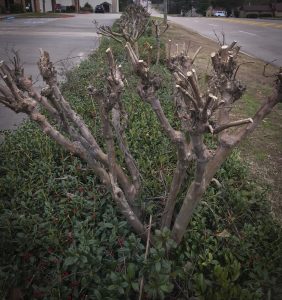Mutilated Myrtle Still Abound
A harbinger of the New Year has unhappily but inevitably arrived. I was running errands. There is a church on the corner where I turn onto Fourth Street to head to the Big Box Stores to which I trek several times a week. This church has rows of crape myrtles on the south and west side of its parking lot. At some point in the past week, landscapers had performed their annual Crape Murder, as some call it. I prefer Crape Myrtle Mutilation. Two rows of those lovely trees, prevalent throughout the South, had been whacked back nearly to the trunk in a ritual that is as ugly as it is unnecessary.

It happens all over the South. Perched on stepladders and armed with lops, landscapers eagerly hack away at these lovely trees, cutting the past year’s growth back. What remains are ungainly torsos. Most people apparently continue to believe that, for this loveliest of Southern ornamentals to bloom in summer, they must be pruned in January.
Most people are wrong. At least about crape myrtles. Every few years, I bemoan this mutilation, in vague hopes that someone will read this and realize they can put away the lops, or quit paying folks to haul off trailers filled with once-healthy branches of their crape myrtles. So far, the mutilators are winning. My complaints are like a tree falling in a forest — or crape myrtle branches falling to the ground.
Crape myrtle mutilation is a Southern tradition from Georgia to Georgetown, Florida to Floydada. Google “crape myrtle mutilation” and dozens of links arrive, most from conscientious arborists and landscapers who decry this barbaric practice. As I have written before, I once belonged, by virtue of slapping a bumper sticker on my Jeep, to a loosely formed organization led by a Nacogdoches landscaper and gardening columnist for the Daily Sentinel newspaper. Pink and green “Stop Crape Myrtle Mutilation” bumper stickers soon graced dozens of vehicles. Thousands of words were published in various newspapers and elsewhere, begging people to quit hacking away at the myrtles.
The hacking continues largely unabated.
Crape myrtles come in various sizes. Folks who want mini-myrtles should buy the variety bred to remain short. Left unchecked, many crape myrtles over years will become stately trees reaching nearly 40 feet in height. Their blooms are luscious yet hardy, able to thrive in 100-degree summers with little water. They can survive an annual mutilation, but the end results are trees with thick trunks and spindly branches.
I am a recovering crape myrtle mutilator. I lived in Nacogdoches at the time and as a single man had purchased a modest house. When January arrived, I hacked away at the half dozen large crape myrtles in the backyard, as instructed by a couple of my buddies who were trying to be helpful. I spent most of a day risking a spinal-cord injury perched on a rickety stepladder, snipping off branches. Then I had to haul the branches to the curb. While complaining later that week about my sore back, our gardening columnist — the originator of the famed bumper sticker — overheard me.
“You don’t have to prune crape myrtles,” he said. “You can just let them grow. Pruning them doesn’t help them bloom; it just makes them look ugly.”
I was delighted to discover that I had spent my final weekend sweating in January carving up crape myrtles. But that leaves the vast majority of Southern landscapers still whacking away, along with the non-believers and those who just haven’t yet learned the news: No pruning necessary.
As for the landscapers, not to be uncharitable, but there isn’t a lot of landscaping work to be done in January. The grass isn’t growing, leaves have quit falling, and it’s too early to plant for spring. Mutilating crape myrtles provides an excuse to keep hard-working folks on the payroll during those slow months. I appreciate the need to keep money flowing for workers, to buy gasoline, etc. I just wish landscapers could think of something else to justify their pay other than turning tens of thousands of crape myrtles into ugly stumps until spring arrives.
As for the homeowners out there who own crape myrtles and do their own yardwork, I hope you read this before spending hours engaged in a totally unnecessary activity. Just think. You could use that time reading a book. That’ s my plan.
Leave a reply
Fields marked with * are required











